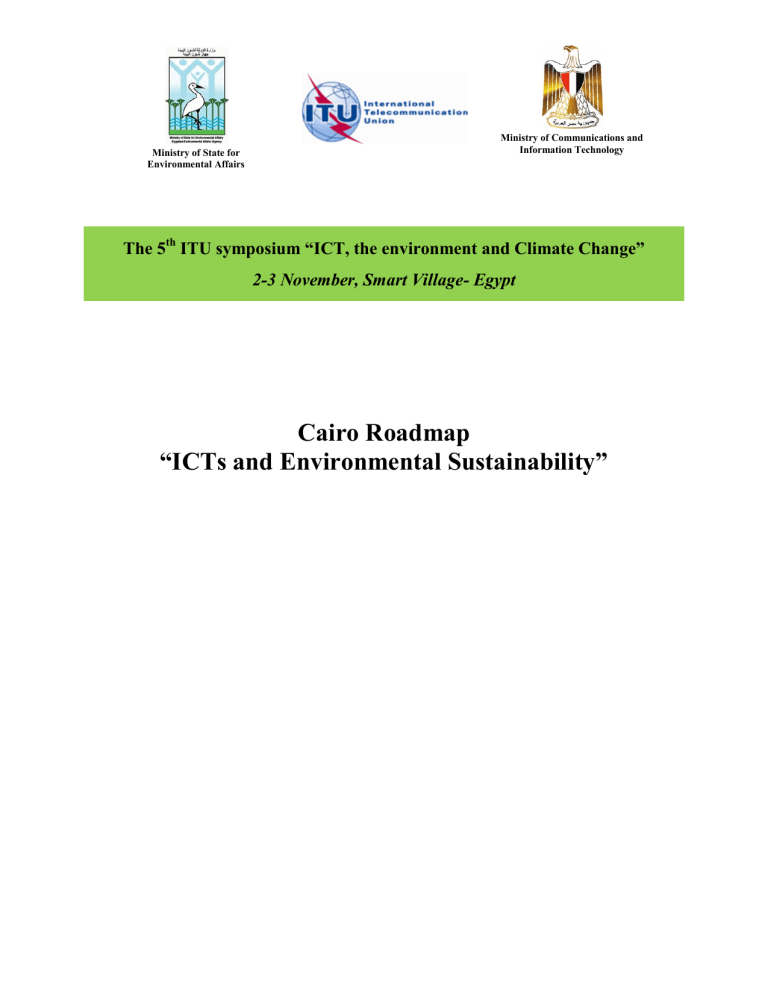Cairo Roadmap “ICTs and Environmental Sustainability” The 5

Ministry of State for
Environmental Affairs
Ministry of Communications and
Information Technology
The 5
th
ITU symposium “ICT, the environment and Climate Change”
2-3 November, Smart Village- Egypt
Cairo Roadmap
“ICTs and Environmental Sustainability”
Cairo Road Map. “ICTs and Environmental Sustainability”
1.
Introduction
The impact of human activities on the environment – and on climate change in particular – are issues of growing concern confronting life on Earth. Improving environmental performance, tackling global warming, enhancing resource management, building capacities, achieving sustainable development,, and raising awareness are among the main global challenges that must be urgently addressed. Information and
Communication Technologies (ICTs) have proven to have a key role in assisting society in mitigating and adapting to climate change.
ICTs are now embedded in almost all sectors of the global society and economy. The digital revolution and proliferation of ICTs have changed people’s lives dramatically and boosted economic growth. The
ICT industry is responsible for around 2-3% of the global Green House Gases (GHG) emissions. On the other hand, ICT solutions have a large potential to enhance performance across the economy and society to reduce the remaining 97-98% of emissions and enhance performance across all sectors of the economy.
Governments and business associations across the world have introduced a range of programs and initiatives on ICT and the environment to address environmental challenges, particularly global warming, energy production, energy use and resource depletion. But it is still too premature to claim that all countries, especially in the developing part of the world, have reached a clear level of understanding of these threats as well as how to exploit the positive potential of ICTs.
The ITU Plenipotentiary Conference in Guadalajara in October 2010 (PP-10) adopted a new resolution on the role of Telecommunications/Information and Communication Technologies on Climate Change and the Protection of the Environment 1 . This identifies the need to assist developing countries in how they can take advantage of the potential of ICTs to tackle climate change. It also identifies the need to encourage the design, implementation and use of energy and resource efficient ICT equipment and solutions, in order to promote a clean and safe environment.
An increasing number of governments in the Middle East North Africa region, including the
Egyptian government, have adopted ambitious plans in smart or green ICTs. This has taken place in cooperation with key stakeholders, seeking to ensure that Green ICTs become an integral part of sustainable green growth.
The 5 th ITU symposium on “ ICTs, the Environment and Climate Change ”, hosted by the Ministry of
Communications and Information Technology and the Ministry of State for Environmental Affairs, Egypt, has played an important role in raising awareness on how ICTs can be used to tackle climate change throughout the developing world and the African continent and Arab States Region in particular. The agenda of the Symposium including a list of speakers can be found at: http://www.itu.int/ITU-T/worksem/climatechange/201011/programme.html
As such, this roadmap has been prepared for government policy makers and ICT stakeholders at all levels to create greater understanding of the positive role that ICTs can play in enhancing environmental sustainability.
2.
Cairo Roadmap on “ICTs and Environmental Sustainability” 2
For countries – whether developed or developing – there is a need to understand the importance and impact of the environment and climate change by national authorities, the public and the country’s development stakeholders. It is also important to understand the specific country risks associated with
1 1 New ITU Resolution “The Role of Telecommunications/Information and Communication Technologies on Climate Change and the Protection of the Environment” (Guadalajara, 2010).
2 Further on referred as “The Cairo Roadmap”
2
Cairo Road Map. “ICTs and Environmental Sustainability” environmental degradation and climate change. Similar approaches are required to help understand the opportunities and risks associated with the greater use of ICTs in general and for managing the environment in particular – within the context of limiting the overall risks associated with climate change.
Based on discussions at the Symposium, the following steps and actions 3 are recommended as a roadmap to enhance the capacities of countries and jurisdictions to use ICTs in support of the environment, i.e. in support of environmental awareness raising, environmental research and management, etc. These steps and actions are aimed at improving environmental performance associated directly with the development, production, use and disposal of ICTs themselves, the wider enabling impacts of ICTs in other areas including buildings and urban systems, transport and power generation and distribution, and in contributing to systemic behavioural change.
Step 1: Share best practices and raise awareness about the benefits associated with the use of green ICTs
Encouraging and, where possible, stipulating the wide sharing of best practices and exchange of information to maximize the diffusion of green ICTs and “smart” ICT solutions in the public and private sector, including information on good practices in measuring environmental impacts of ICTs, and their wider economic and social impacts.
Promoting green ICT related education, training and skill development to meet the demand for environmental skills and expertise at all levels. Encouraging interdisciplinary co–operation in developing green ICT education and training and building cadres in green ICTs.
Increasing public awareness of the environmental implications of using ICTs. Promoting widespread development and adoption of standards based on a life cycle assessment of ICT goods and ICT solutions. Maximizing knowledge of the environmental impacts of ICTs.
Step 2: Demonstrate success and feasibility
Encouraging the development of methodologies such as the ITU-T Study Group 5 Recommendations on “ Methodologies for assessing the environmental impact of ICT” 4 as well as indicators to measure and monitor environmental impacts along the complete ICT devices and services life cycles, including baseline measures of embedded green-house gases and green-house gas emissions. Using compatible assessments to evaluate the potential of “smart” ICT solutions and management practices
(e.g. smart transport or building management systems) to reduce energy consumption and greenhouse gas emissions 5 .
Use pilot and flagship demonstration projects to help diffuse promising “smart” ICT solutions in sectors such as buildings, transportation and energy systems.
Step 3: Engage the private sector, civil society and academic community
The private sector, civil society and academic community have a major roles in the protection of the environment through innovation and making use of ICTs for sound environmental management to tackle climate change.
3
Some of the steps and actions suggested in this document were extrapolated from the Recommendation of the Council on
Information and Communication Technologies ad Environment, OECD, 2010 and from the ICTs for e-Environment - Guidelines for Developing Countries, with a Focus on Climate Change” available at http://www.itu.int/ITU-D/cyb/app/e-env.html
4 ITU-T Study Group 5, see http://www.itu.int/ITU-T/climatechange/
5 See http://www.itu.int/ITU-T/worksem/climatechange/201011/ for an example of an ITU supported assessment that is piloted by
Egypt for assessing the potential for using ICTs to reduce energy consumption and reduce greenhouse gas emissions in the built environment.
3
Cairo Road Map. “ICTs and Environmental Sustainability”
Ensuring life cycle perspectives in ICT and ICT-related solutions for sustainable management of natural resources and materials in production, use, and end-of-life phases. Promoting coherent environment-friendly and socially responsible R&D, design, production, use and disposal of ICTs, and extending their working life wherever environmentally efficient.
Encouraging ICT Sector to invest in appropriate ICT based applications.
Implementing effectively the net polluter pays principle.
Observing the existing obligations under the Multilateral Environment Agreements and National
Regulations pertaining to e-waste and hazardous wastes, namely the Prior Informed Consent before exportation, ensuring that the importing countries has the technical capacity to recycle and dispose ewaste in an environmental sound way supported by technical assistance from International
Organizations, and the principle of. extended producers responsibility.
Step 4: Promoting national, regional and international cooperation
Cooperating at international, regional and national level to encourage the move towards sustainable low-carbon economies, green investment and sustainable management of natural resources, as well as the development and diffusion of clean technologies and finally, encouraging developed countries to support developing countries efforts including through adopting domestic policy reform to become more pro-green growth.
Promoting co-operation and exchange of knowledge between ICT and non-ICT firms, international organizations, research institutes and governments, and civil society.
Seeking ways to integrate ICT policies as part of the ongoing dialogue on climate change within international organizations such as the United Nations Framework Convention on Climate Change
(UNFCCC).
Seeking ways to integrate ICT policies within the Intergovernmental Panel on Climate Change
(IPCC).
Encouraging national, regional and international ICT cooperation for environmental sustainability, enhancing partnerships between developing countries, and between developed and developing countries to address global environmental challenges, and strengthening international governance to better tackle global environmental challenges, increasing attention to the relationship between ICTs and the environment in development cooperation programs, and promoting more coherent policies in this respect.
Making available adequate financial resources to build the capacity of developing countries to better use ICTs to protect the environment and using ICTs to enhance technology transfer ,diffusion and dissemination.
Step 5: Integrating ICT, climate, environment and energy policies
Bridging the gap between ICT, environment and energy experts and policy makers, to allow the integration of ICT into environment and energy policies to improve environmental performance, tackle global warming, enhance energy efficiency and resource management.
Integrating the use of ICT in national adaptation plans to make use of ICTs as an enabling tool to address the effects of climate change.
Minimizing the environmental impact of public administration through green ICT approaches, policies, applications and services, by implementing initiatives such as (a) taking greater account of environmental criteria in public procurement of ICT goods and increase environmental innovation among suppliers; (b) maximizing resource efficiency of public facilities including through by the use of “smart” ICT applications in energy efficiency, (i.e. lighting, heating and cooling, and building
4
Cairo Road Map. “ICTs and Environmental Sustainability” control); or (c) enhancing process efficiency and organizational change in public administration through tele-working and videoconferencing to reduce commuting and travelling in order to reduce
GHG emissions.
Setting transparent policy objectives and targets to improve government strategies. Monitoring and evaluating the enforcement of policies on a regular basis to set clear responsibilities and improve accountability. Applying voluntary approaches where self-monitoring and self-reporting are effective and achievable.
Step 6: Develop and implement a National Pro-Growth Green ICT strategy
The strategy should start to address the question at a national, sub-national, municipality and community levels as well as at the individual organization level. The Green ICT strategy has to be seen as a component of the national development strategy. The strategy and action plan for using ICTs in support of sound environmental management and decision taking should touch on all sectors of the economy and at all levels of society. Technical support should be provided to needing countries, especially developing countries, to help them formulate and implement Green ICT strategies and implementation plans. The strategy should include an assessment phase that includes, inter-alia, the following steps or components:
An e-readiness assessment to help understand ICT use at the national level and in the environment sector;
A situation analysis assessing the use of ICTs for environmental research, management and planning;
Identifying key players and stakeholders;
Identify gaps and obstacles faced during the formulation of the strategy and in the implementation phase, and report success stories in dealing with such challenges;
Looking at some key issues, such as how countries are meeting their obligations under the various international and regional conventions and agreements;
A strategic analysis to identify the objectives, challenges and opportunities regarding the use of ICTs in dealing with the environment;
A benchmark study comparing and contrasting the situation nationally with that in other countries or jurisdictions, i.e. where the country stands at present compared with other countries and jurisdictions;
Case studies and best practice analyses;
A feasibility report.
5








